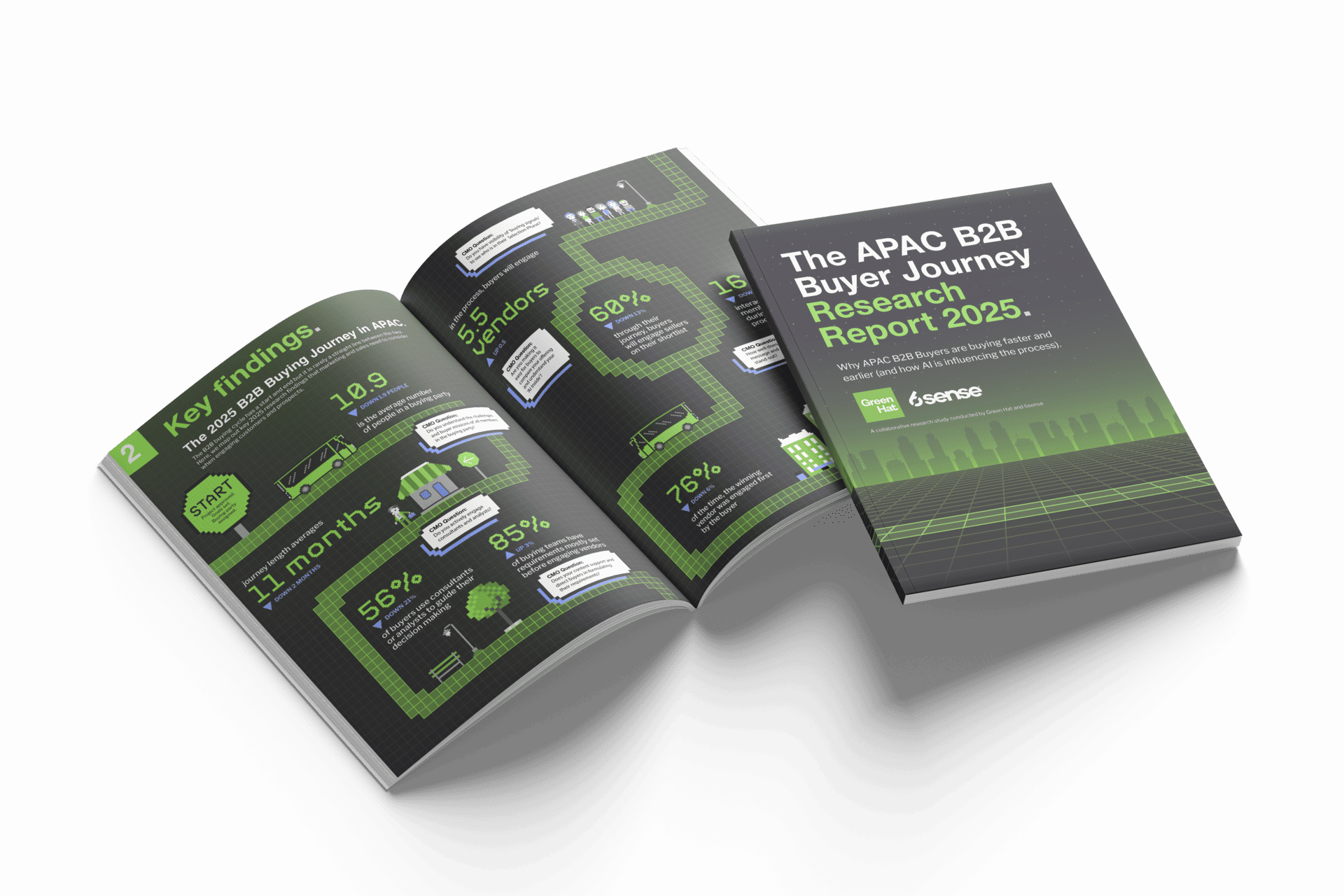The economic downturn lingers, but is also creating new opportunities
It has been a challenging time for the Professional Services industry – COVID disrupted the industry, accelerating digital transformation to aid remote working. The post-COVID economic downturn saw reduced demand for professional services such as consulting, legal, and accounting. And, the PwC tax scandal in Australia has focused discussions on trust and integrity in the sector.Against this backdrop, the industry continues to demonstrate its resilience and there remains significant opportunity for professional services organisations to grow. Buyers are broadening their consideration set beyond the Big 4 and new legislation such as Employment Services reform, right to disconnect legislation and CPS230 will provide the industry with new opportunities.
For B2B marketers in the professional services sector to take advantage of these opportunities, they must have a deeper and more nuanced understanding of how their potential buyers behave. Green Hat’s research report “The APAC B2B Buyers Journey report” provides just that - key insights into the behaviour of the buying party.
Are professional services firms persuading the real buyers?
The implications of the research are clear: to gain a competitive advantage, professional services firms need to challenge the norms of the industry and break away from outdated practices, such as:- Lack of brand investment
- The fixation on MQLs
- No desire to differentiate
These practices have been talked about for years, but to address them, let’s start by considering the key findings from the research report. Here are the key facts that B2B marketers in the professional services sector should be aware of:
- B2B marketing is Buyer Group Marketing. The average size of the buying group that procures professional services is 15 people. This group size often increases as, in 77% of cases, the buying organisation engages a consultant to help with the decision (yes that’s right: there are consultants who help procure consultants…).
- B2B buying teams contain two types of buyers – product buyers and process buyers. Product buyers review product specs to make sure it meets requirements. Process buyers are more concerned about risk and compliance than the actual solution itself. Process buyers are often hidden and have the power to veto buying decisions.
- During the course of the typical 16.7 month buying journey, the buying group will have an average of 20 interactions per person with each of 5.9 potential vendors. That’s a whopping 2,188 interactions.
- The buying group will wait until it is 75% of its way through the buying journey before reaching out to potential vendors. We call this period the selection stage.
- Once they’ve selected the vendors they want to work with, buying groups move to the validation stage and when they do:
- 67% initiate the first contact. That’s right: they will call you, not the other way around.
- In 61% of instances, the first buyer that they reach out to will go on to win the business.
- 88% of them will have their requirements mostly set by the time they start contacting vendors. Once they’ve selected the vendors they want to work with, buying groups move to the validation stage and when they do:
- Even in the 39% of buying decisions where first contact is initiated by the seller, that interaction still occurs when the buyer is 75% of the way through the buying journey – at the stage when they were ready to start talking and move to validation.
So, what does all this mean for professional services marketers? There are four key marketing implications that emerge from these findings.
The four key takeaways for professional services marketing leaders
1. Build your brand
The primary issue professional services organisations face is visibility and recognition among the buyer group. Professional services is a crowded space and historically the industry has worked on referrals, but that alone is no longer enough. With buyers doing their own research, hidden from view, brand recognition and awareness are becoming essential for growth.
The research tells us that buyers of professional services are 75% of the way through the buying decision when they are ready to talk to you. And once they are ready to talk, they’ve largely decided who they want to do business with (the first business contacted is the one that wins the deal 61% of the time).
To win, professional services marketers must invest in building brand awareness, increasing mental availability and increasing brand trust amongst their entire ICP/TAL. They need to do this because buying groups will prioritise professional services providers they are familiar with i.e. those presenting the lowest risk.
A great recent example of this is Grant Thornton’s ABC campaign featuring Australian Olympian, Jess Fox. A brave piece of work that moves beyond the norms of the category and creates strong brand visibility.
2. Ignore the hidden buyers at your peril
The 15-strong buying party is not a homogenous group. A better way to think about it is the buying party being made of two broad camps - 51% are functional buyers (the ones that will use the service) and the other 49% are hidden buyers. The hidden buyer camp may include the CEO, CFO, procurement, consultants and others. Engaging with the hidden buyers is critical as they have right of veto at the start, middle and the end of the buying decision.
The hidden buyers’ role in the buying group is different to that of the functional buyers and consequently their content needs are very different. Ultimately, they are in the risk mitigation business. They will look to do business with organisations that they know and that they can trust. This is where the idea for the “nobody ever got fired for buying IBM” campaign came from.
Knowing this, professional services marketers must ensure they know who the hidden buyers are and then focus on building up brand awareness and trust among them.
If the hidden buyers don’t know or trust you, you are likely to be on the wrong side of their veto power at the start, middle or end of the buying process.
3. Count Marketing Qualified Leads (MQLs) but don't obsess over them
B2B marketing is buyer group marketing, so why the focus on MQLs in professional services? By the way, if you're not measuring MQLs yet, don't stress. You have the opportunity to leapfrog this step entirely and go straight to account-level marketing.
For the MQL enthusiasts out there, by its very definition, an MQL is the name and contact details of just one person from a buying side organisation. Should this really be your focus?
At the stage a ‘lead’ is submitted you have no idea where the organisation is at in their buying cycle or if they are even buying – maybe you forced them to provide their details to download a piece of gated contact (more to come on that point). If that ‘lead’ was submitted at the start of a buying cycle then they won’t want to talk to you. There is a real risk that you will put them through a nurture cycle, or qualify them out as not interested. They were interested, just not yet.
Further, if that lead is submitted when the buying party is ready to talk, it’s probably too late for you as the buying group has already decided on its preferred vendor at the time of going to market.
Fortunately, technology can help us here. Using VI tags and intent data, you have the ability to deanonymize your web traffic and identify the 97%+ that don’t fill out a web form. With this data you can move away from individuals and start to measure and optimise for account engagement and progression, which are far more relevant as buying signals.
And please please please un-gate your content. B2B buyers are savvy, they know why you want their details and they don’t want to hand them over only to receive a sales call a few hours later. Trust the content that you have invested your scarce marketing budget into developing will do the job that it is intended to – educate, assure, inspire, inform and engage your ICP/TAL. If you achieve this, they will reach out to you.
4. Make yourself easy to buy from
Distinction over differentiation? In this case yes. Buying groups know what they are looking for and they are evaluating multiple vendors. They want the ability to compare. The harder you make this for them, the less likely that they are to want to do business with you.
Study the key category entry points for your product and services – understand why the buying group comes into market and then provide content that demonstrates how you can solve for it.
Consider the language that is used in RFPs that you respond to (the buyer’s questions, not your responses). Develop content such as buying guides that create utility and add value to the buying group while they are at the research stage of their journey.
The buying party is multi-dimensional, and your marketing should be too
The research shows that buyers of professional services don’t necessarily favour one type or marketing activity over another. What matters most is how professional services marketers create visibility among their target accounts, how they track engagement with the buying group, and how their marketing strategy addresses the needs of the whole buying party, including the hidden buyers.
Ready to tap into your ICP’s buying group and take your B2B marketing to the next level? Get in touch with us and let’s have a conversation.

 Brand
Brand Strategy
Strategy


.png)
.png?width=900&name=shutterstock_2484595495%201%20(1).png)
%20Blog_Blog%20header%20image_1200x1200.png?width=900&name=ZZ%20GH%20Marketing%20Task%20Golden%20Bee%20Awards%20(Kilcoy)%20Blog_Blog%20header%20image_1200x1200.png)
